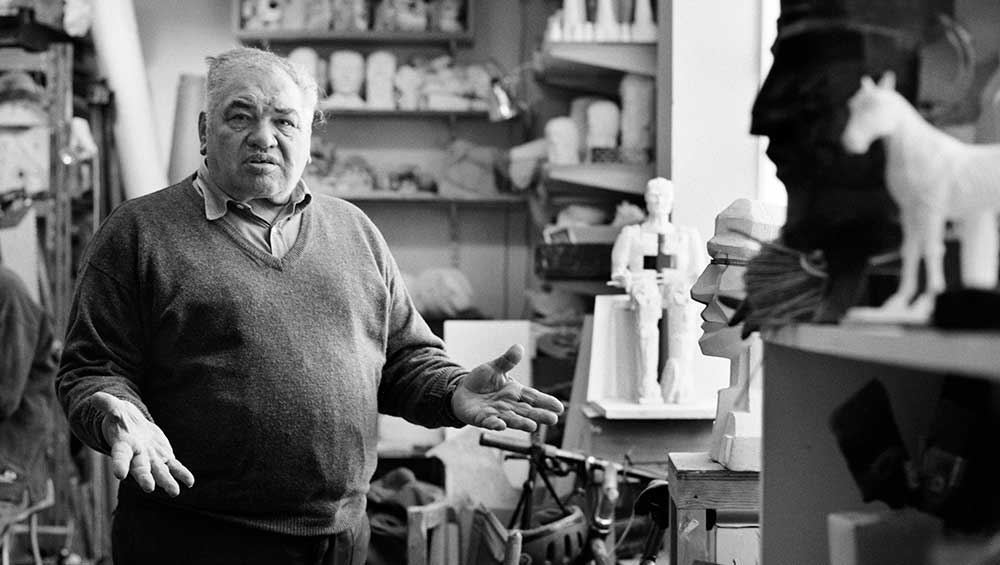
Debra Hurford Brown, Eduardo Paolozzi, 1999, 2003. National Galleries Scotland.
Modern Two, National Galleries of Scotland, Edinburgh
27 January – 21 April 2024
by BETH WILLIAMSON
As its name indicates, this exhibition in Edinburgh celebrates the centenary of the birth of the Scottish-Italian artist Eduardo Paolozzi (1924-2005). Paolozzi was born nearby in Leith, so there is a great deal of local pride in an artist who achieved international attention and success over more than six decades. Spread across the ground floor galleries of Modern Two, National Galleries of Scotland, the exhibition is a tribute to the artist through a small selection of his works including collages, prints, textiles, ceramics and sculpture.
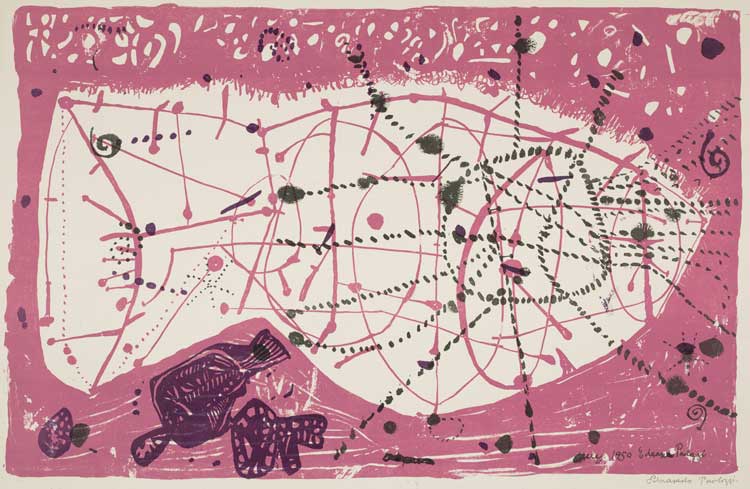
Eduardo Paolozzi, Marine Composition, 1950. Colour lithograph on paper. Purchased 1978. © Trustees of the Paolozzi Foundation. Licensed by DACS, London 2023.
All the works shown are drawn from Scotland’s national collection (many gifted in a major bequest by the artist in 1995) and shown in Modern Two alongside work on permanent display – the atmospheric recreation of Paolozzi’s London studio, and his gargantuan Vulcan sculpture (a cyborg figure more than 7 metres heigh) that dominates the cafe space, with the impressive Cleish Castle Ceiling Panels above. The panels were originally commissioned by the architect Michael Spens for Cleish Castle in Kinross. Outside, meanwhile, is Paolozzi’s commanding sculpture Master of the Universe (1989), based on William Blake’s famous drawing of Isaac Newton. This is a similar but smaller version of the sculpture situated in the courtyard of the British Library in London.
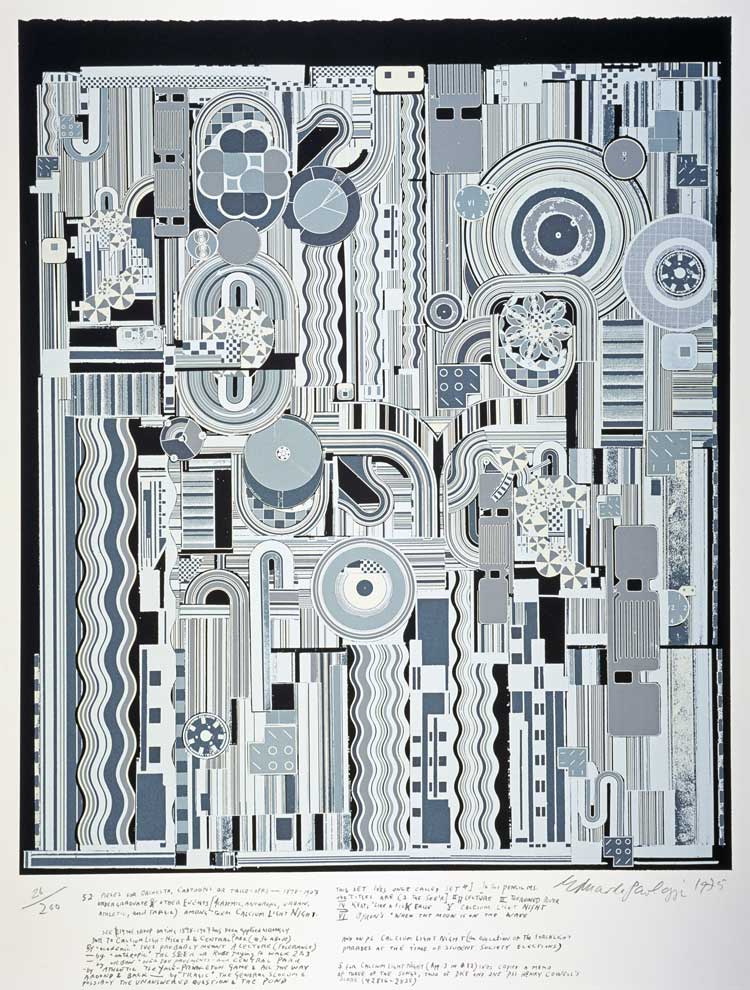
Eduardo Paolozzi, Calcium Light Night (from ‘Calcium Light Night’), 1974-76. Screenprint on paper. Presented by the artist 1994. © The Paolozzi Foundation, Licensed by DACS/Artimage 2023.
The temporary exhibition itself, which runs for three months, fills two gallery spaces and extends into a special display within the Keiller Library. For such an incredibly prolific and diverse artist, it is difficult to know how you would select 60 or so works to represent the span of his long career. This exhibition has addressed that difficulty by choosing to group works together largely by media, an approach that has its advantages. However, the display feels skewed towards Paolozzi’s printmaking, particularly the Calcium Light Night (1974-76), and the As Is When (1964-65) series of prints (the latter dedicated to an exploration of the writings of the German philosopher Ludwig Wittgenstein), and three artist’s proofs of Illumination and the Eye (1967).
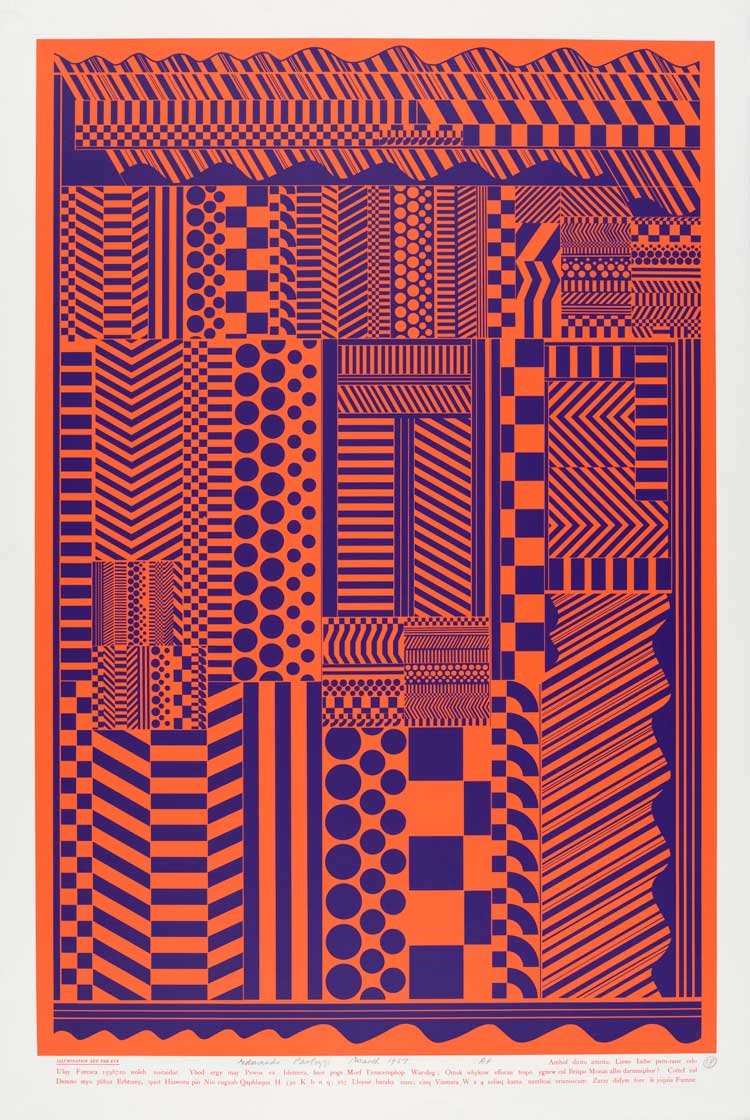
Eduardo Paolozzi, Illumination and the Eye, 1965. Screenprint on paper. Presented by the artist 1994. © Trustees of the Paolozzi Foundation. Licensed by DACS, London 2023.
That said, it was particularly good to see multiple mentions of Paolozzi’s earlier working relationships at the Central School of Arts and Crafts in London with the Austrian art theorist Anton Ehrenzweig, who acted as his print technician, and with the principal, the Scottish artist William Johnstone. The multiple examples of small design exercises included in this exhibition were made by Paolozzi c1950, around the period when Johnstone was instrumental in introducing “Basic Design” training at the Central School.
In the art school of the 1950s in Britain, Basic Design emerged as a radical new form of artistic training. It was the first attempt to create a formalised system of artistic knowledge based on an intuitive approach to art teaching. It took its inspiration from the Bauhaus curriculum and students began to use different techniques and materials to explore the fundamental principles of line, space, form and colour. These sorts of explorations are evident in Paolozzi’s work too. It is almost a decade since these important influences and relationships of Paolozzi’s have been researched and written about in the academic field so it is good to see this finally being acknowledged in museum spaces and shared with wider audiences. Those relationships were established while Paolozzi was working at the Central School in the early 50s and other figures from that time, including Nigel Henderson, while mentioned, don’t get as much attention as might be expected in this exhibition, especially given the importance of Paolozzi’s work with Henderson under the banner of Hammer Prints.
.jpg)
Eduardo Paolozzi, The Silken Worlds of Michelangelo (from Moonstrips Empire News), 1967. 100 photolithographs and screenprints on paper and acetate in plexiglass box. Presented by the artist 1994. © Trustees of the Paolozzi Foundation. Licensed by DACS, London 2023.
The Keiller Library houses a special display relating to public art in this exhibition. In many respects, the dimmed lighting and small enclosed space shouldn’t work for a consideration of public work, but it really does. Public art was an important aspect of Paolozzi’s work. As he explained its attraction: “In any form of public art – designs for an underground station or sculpture in a city square – one knows that one is making a kind of bridge, contact with people on a massive scale.” Commissions considered in this display include Camera (1978-9) in Munich, the Tottenham Court Road underground station mosaics (completed in 1986) in London, and The Manuscript of Monte Cassino (1991) and The Wealth of Nations (1993), both of which are located in the city of Edinburgh itself. This display uses archival material to tell the stories of how these public artworks came into existence, from commissioning, to making, to installation and, in the case of the Tottenham Court Road mosaics, also includes fragments of the work removed when station renovations began in 2015 – a poignant reminder that public artworks are always at risk when sites are renovated or redeveloped.
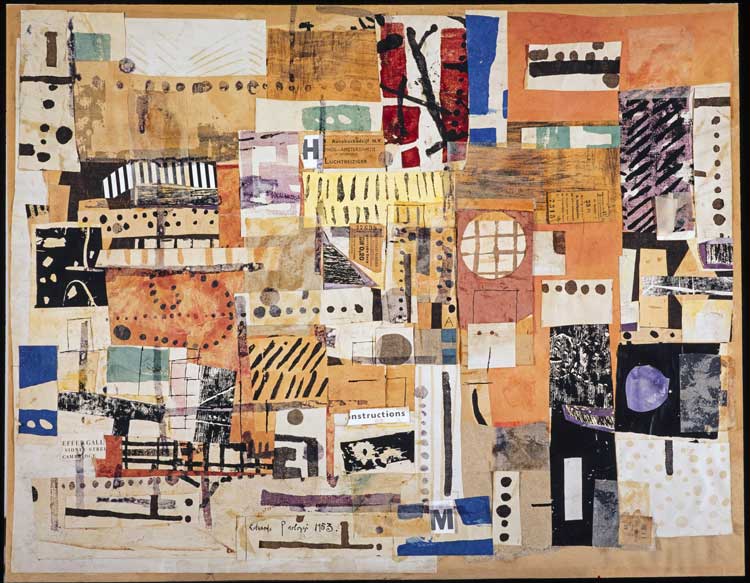
Eduardo Paolozzi, Collage, 1953. © The Paolozzi Foundation, Licensed by DACS Artimage 2023.
Paolozzi’s various approaches to collage work is rightfully given attention in this exhibition too. There are an almost infinite number of these in galleries, museums and private collections across the world. One shown here Collage (1953) bequeathed by Gabrielle Keiller is a nice example of where the artist’s magpie habit of collecting tickets and scraps of magazines, comes together with fragments of his experimental printmaking at the Central School. In that environment, it was Johnstone’s openness that enabled artist-teachers to experiment and develop their own practice and work collaboratively, while also teaching a new generation of artists. Also shown in this exhibition are a small number of bronze sculptures from the same period including Saint Sebastian (1957), Krokadeel (c1956-59) and His Majesty the Wheel (1958-59) all of which were constructed using a collage-type technique.
There are textiles, tapestries and ceramics in this exhibition, too, and the display of ghostly white plaster maquettes that flank the entrance to the Keiller Library echo the hundreds within the recreated studio at the other end of the exhibition and lend balance. It is a pity that quite so much space has been given over to Paolozzi’s printmaking in this exhibition but ultimately it gives a fair sense of the range of Paolozzi’s ideas and making, particularly for visitors unfamiliar with his work.